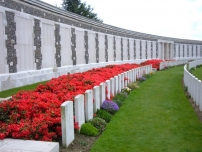| First Name: | John Albert | Last Name: | RUDKIN | |
|---|---|---|---|---|
| Date of Death: | 16/08/1917 | Lived/Born In: | Maida Vale | |
| Rank: | Rifleman | Unit: | Royal Irish Rifles14 | |
| Memorial Site: | Tyne Cot Memorial, Belgium | |||
Current Information:Age-30 9, Denholme Road, Maida Vale
Third Battle of Ypres This was a campaign fought between July and November 1917 and is often referred to as the Battle of Passchendaele, a village to the north-east of Ypres which was finally captured in November. It was an attempt by the British to break out of the Ypres salient and capture the higher ground to the south and the east from which the enemy had been able to dominate the salient. It began well but two important factors weighed against them. First was the weather. The summer of 1917 turned out to be one of the the wettest on record and soon the battlefield was reduced to a morass of mud which made progress very difficult, if not impossible in places. The second was the defensive arrangements of concrete blockhouses and machine gun posts providing inter-locking fire that the Germans had constructed and which were extremely difficult and costly to counter. For 4 months this epic struggle continued by the end of which the salient had been greatly expanded in size but the vital break out had not been achieved. The Battle of Langemarck This took place between 16th-18th August, 1917 and was the second general attack of 3rd Ypres. Although it did not rain during the two days of the battle itself there had been plenty of it in the preceding days and in many places the battlefield was a quagmire. On the left of the attack in the north-west of the Ypres salient there was considerable success, especially for the French Army which attacked on the left of the British, but the attack on the Gheluvelt Plateau, due east of Ypres, met determined German resistance and the early gains were soon reversed. On 16th August, 1917, 36th Division attacked at 4.45am north of the Ypres-Roulers railway and had to cross a mile of open ground to their objectives, the Anzac and Zonnebeke spurs. 109 Brigade on the left attacked with the 14th Royal Irish Rifles and 11th Royal Inniskilling Fusiliers battalions in front, 9th Royal Inniskilling Fusiliers in support and 10th Royal Inniskilling Fusiliers in reserve. They had to wade through a swamp caused by the flooded Steenbeek during which they came under machine-gun fire from enemy strong points at Pond Farm and Border House. The protective artillery barrage was lost and the attack stopped. Nevertheless they managed to occupy Fortuin, 400 yards from the start but got no further forward. Among the many casualties suffered by the division during the fighting on this day was John Rudkin of 14th Royal Irish Rifles. |
||||
| « Back to Search Results | ||||
| If you think any of the information shown here is incorrect, Click Here to submit your amends and comments | ||||




